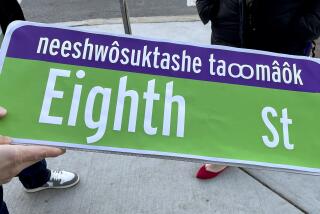Voices From the Past Open Doors to Different Ways of Life
- Share via
FAIRBANKS, Alaska — Sit down at one of two desktop computers at the University of Alaska Fairbanks library and you can hear voices from the past come to life.
Project Jukebox, part of UAF’s Oral History Program, blends digitized recordings with historic photographs, maps, text and sometimes video clips.
Viewers can explore the history of the Yukon River village of Rampart, hear commentary on 1930s photos from Barrow and listen to climbers discuss pioneering ascents of Mt. McKinley.
Technology could make the information available to millions via the Internet, but human concerns keep the stories confined to the library.
Many of the voices in the UAF collection are from Alaska Native cultures, where the retelling of stories and traditions are governed by strict codes. Putting them on the Internet, said oral history curator William Schneider, leaves them vulnerable to uses that the groups did not intend.
“The challenge is now to try to work through some of the issues of making this stuff available on the Web,” Schneider said.
Project Jukebox started in 1988 when the Oral History Program, part of the Alaska and Polar Regions Department of the Elmer E. Rasmuson Library, faced budget cuts and looked for inexpensive ways to develop uses for taped interviews.
A graduate student, Felix Vogt, came up with the idea of digitizing tape recordings. An Apple Computer grant helped launch the project.
Today Project Jukebox has 29 programs with more than 400 hours of interviews. In one, pioneering scientists at the Geophysical Institute tell in their own words what it was like to design Arctic scientific experiments to study the northern lights and other natural phenomena.
“It’s what science is all about,” Schneider said proudly. “It’s innovative and it’s creative. It’s great stuff.”
But when it comes to Alaska Native cultures, Schneider treats the words as the UA Museum treats a fragile woven basket.
“There’s such a thing as cultural values,” said Rosita Worl, executive director of the Sealaska Heritage Foundation, devoted to preserving and enhancing the cultures of Tlingit, Haida, and Tsimshian Indians.
The Southeast Alaska cultures have a strong tradition of intellectual property, stories, songs, names, and crests. Native American property historically has not been accorded the same protections as property of other cultures, she said.
“A lot of the public doesn’t know what these things mean to Native people,” Worl said.
A traditional scholars council oversees Sealaska Heritage oral history activities. The foundation has videotaped ceremonies but acknowledges potential for abuse, for example, in a ceremony that calls forth spirits.
They do not want their culture trivialized.
“We like people to know about our culture, but we like to know it’s accurate and people know the context of it,” she said.
John Neuenschwander, professor of history at Carthage College in Kenosha, Wis., who worked on ethical and legal guidelines for the national Oral History Assn., said he was not familiar with UAF’s policies but the school would not be alone in its reluctance to post oral history on the Internet.
Colleges and historical associations are more likely to post lists of taped interviews rather than sound files, he said.
“Most oral history programs are not willing to jump in there and make everything available,” Neuenschwander said, because of the potential for harm.
Seeking relief for a copyright violation is expensive, he said. Institutions retain a control by making users sign agreements promising not to misuse material.
UAF oral historians consider themselves collaborators with community members, who agree to be interviewed for Project Jukebox.
“We try not to produce anything that hasn’t been reviewed at least at the local level,” he said.
UAF research assistant Karen Brewster said UAF oral historians have applied for a federal grant to pay for wider distribution. They would like to revisit communities and ask people whether their words should be distributed worldwide.
Schneider said a first step probably will be putting the information on smaller networks controlled by museums, school districts or historical associations.
“I’d like to work locally and regionally first, sort of testing the waters,” he said.
There’s no need to travel to Fairbanks to obtain the library’s 8,845 audio tapes. More than 1,400 are indexed and can be ordered through the interlibrary loan system. Casual users are not likely to go to the trouble.
“The issue there is degree of public exposure,” Schneider said.
More to Read
Sign up for The Wild
We’ll help you find the best places to hike, bike and run, as well as the perfect silent spots for meditation and yoga.
You may occasionally receive promotional content from the Los Angeles Times.






